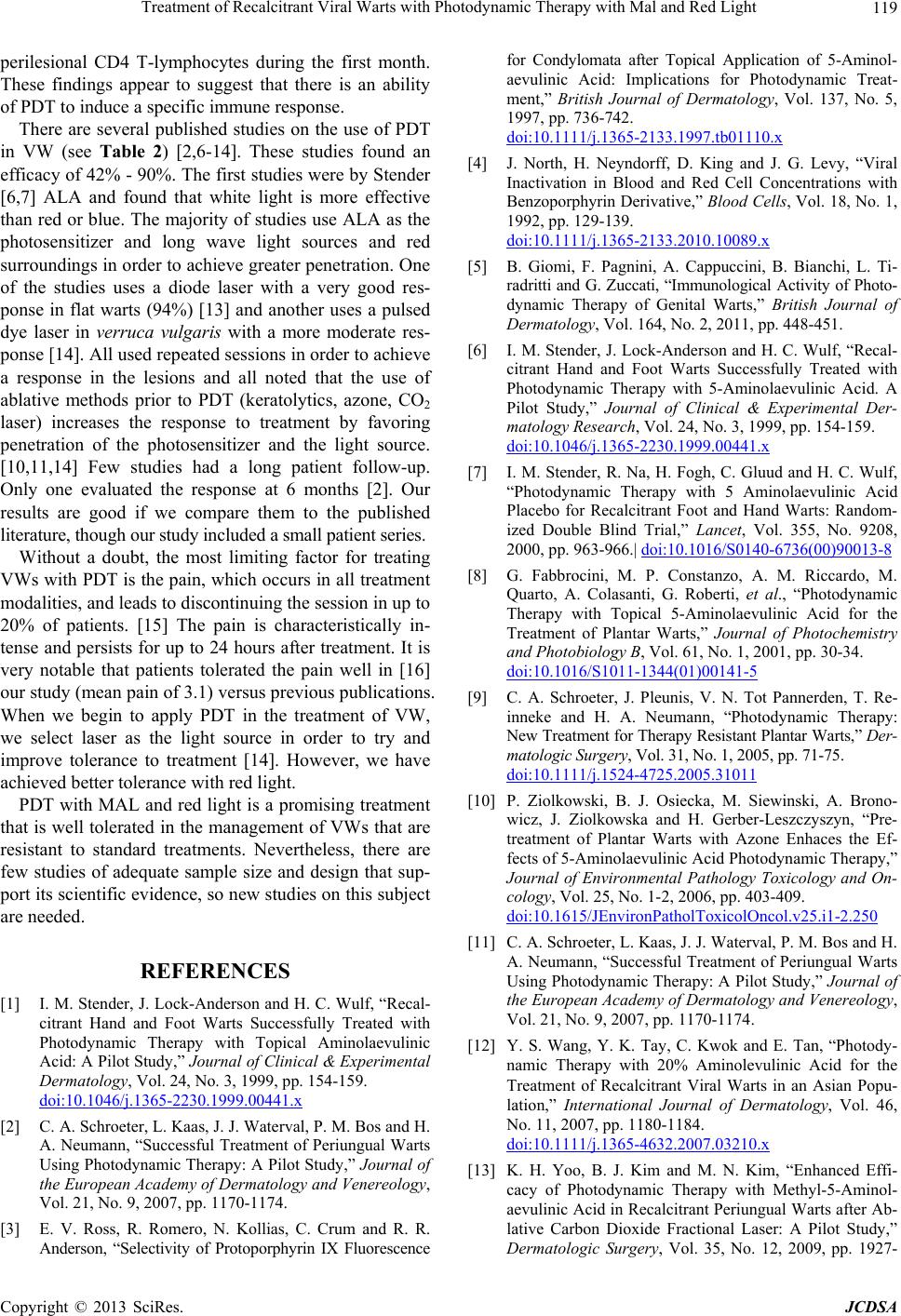
Treatment of Recalcitrant Viral Warts with Photodynamic Therapy with Mal and Red Light 119
perilesional CD4 T-lymphocytes during the first month.
These findings appear to suggest that there is an ability
of PDT to induce a specific immune response.
There are several published studies on the use of PDT
in VW (see Table 2) [2,6-14]. These studies found an
efficacy of 42% - 90%. The first studies were by Stender
[6,7] ALA and found that white light is more effective
than red or blue. The majority of studies use ALA as the
photosensitizer and long wave light sources and red
surroundings in order to achieve greater penetration. One
of the studies uses a diode laser with a very good res-
ponse in flat warts (94%) [13] and another uses a pulsed
dye laser in verruca vulgaris with a more moderate res-
ponse [14]. All used repeated sessions in order to achieve
a response in the lesions and all noted that the use of
ablative methods prior to PDT (keratolytics, azone, CO2
laser) increases the response to treatment by favoring
penetration of the photosensitizer and the light source.
[10,11,14] Few studies had a long patient follow-up.
Only one evaluated the response at 6 months [2]. Our
results are good if we compare them to the published
literature, though our study included a small patient series.
Without a doubt, the most limiting factor for treating
VWs with PDT is the pain, which occurs in all treatment
modalities, and leads to discontinuing the session in up to
20% of patients. [15] The pain is characteristically in-
tense and persists for up to 24 hours after treatment. It is
very notable that patients tolerated the pain well in [16]
our study (mean pain of 3.1) versus previous publications.
When we begin to apply PDT in the treatment of VW,
we select laser as the light source in order to try and
improve tolerance to treatment [14]. However, we have
achieved better tolerance with red light.
PDT with MAL and red light is a promising treatment
that is well tolerated in the management of VWs that are
resistant to standard treatments. Nevertheless, there are
few studies of adequate sample size and design that sup-
port its scientific evidence, so new studies on this subject
are needed.
REFERENCES
[1] I. M. Stender, J. Lock-Anderson and H. C. Wulf, “Recal-
citrant Hand and Foot Warts Successfully Treated with
Photodynamic Therapy with Topical Aminolaevulinic
Acid: A Pilot Study,” Journal of Clinical & Experimental
Dermatology, Vol. 24, No. 3, 1999, pp. 154-159.
doi:10.1046/j.1365-2230.1999.00441.x
[2] C. A. Schroeter, L. Kaas, J. J. Waterval, P. M. Bos and H.
A. Neumann, “Successful Treatment of Periungual Warts
Using Photodynamic Therapy: A Pilot Study,” Journal of
the European Academy of Dermatology and Venereology,
Vol. 21, No. 9, 2007, pp. 1170-1174.
[3] E. V. Ross, R. Romero, N. Kollias, C. Crum and R. R.
Anderson, “Selectivity of Protoporphyrin IX Fluorescence
for Condylomata after Topical Application of 5-Aminol-
aevulinic Acid: Implications for Photodynamic Treat-
ment,” British Journal of Dermatology, Vol. 137, No. 5,
1997, pp. 736-742.
doi:10.1111/j.1365-2133.1997.tb01110.x
[4] J. North, H. Neyndorff, D. King and J. G. Levy, “Viral
Inactivation in Blood and Red Cell Concentrations with
Benzoporphyrin Derivative,” Blood Cells, Vol. 18, No. 1,
1992, pp. 129-139.
doi:10.1111/j.1365-2133.2010.10089.x
[5] B. Giomi, F. Pagnini, A. Cappuccini, B. Bianchi, L. Ti-
radritti and G. Zuccati, “Immunological Activity of Photo-
dynamic Therapy of Genital Warts,” British Journal of
Dermatology, Vol. 164, No. 2, 2011, pp. 448-451.
[6] I. M. Stender, J. Lock-Anderson and H. C. Wulf, “Recal-
citrant Hand and Foot Warts Successfully Treated with
Photodynamic Therapy with 5-Aminolaevulinic Acid. A
Pilot Study,” Journal of Clinical & Experimental Der-
matology Research, Vol. 24, No. 3, 1999, pp. 154-159.
doi:10.1046/j.1365-2230.1999.00441.x
[7] I. M. Stender, R. Na, H. Fogh, C. Gluud and H. C. Wulf,
“Photodynamic Therapy with 5 Aminolaevulinic Acid
Placebo for Recalcitrant Foot and Hand Warts: Random-
ized Double Blind Trial,” Lancet, Vol. 355, No. 9208,
2000, pp. 963-966.| doi:10.1016/S0140-6736(00)90013-8
[8] G. Fabbrocini, M. P. Constanzo, A. M. Riccardo, M.
Quarto, A. Colasanti, G. Roberti, et al., “Photodynamic
Therapy with Topical 5-Aminolaevulinic Acid for the
Treatment of Plantar Warts,” Journal of Photochemistry
and Photobiology B, Vol. 61, No. 1, 2001, pp. 30-34.
doi:10.1016/S1011-1344(01)00141-5
[9] C. A. Schroeter, J. Pleunis, V. N. Tot Pannerden, T. Re-
inneke and H. A. Neumann, “Photodynamic Therapy:
New Treatment for Therapy Resistant Plantar Warts,” Der-
matologic Surgery, Vol. 31, No. 1, 2005, pp. 71-75.
doi:10.1111/j.1524-4725.2005.31011
[10] P. Ziolkowski, B. J. Osiecka, M. Siewinski, A. Brono-
wicz, J. Ziolkowska and H. Gerber-Leszczyszyn, “Pre-
treatment of Plantar Warts with Azone Enhaces the Ef-
fects of 5-Aminolaevulinic Acid Photodynamic Therapy,”
Journal of Environmental Pathology Toxicology and On-
cology, Vol. 25, No. 1-2, 2006, pp. 403-409.
doi:10.1615/JEnvironPatholToxicolOncol.v25.i1-2.250
[11] C. A. Schroeter, L. Kaas, J. J. Waterval, P. M. Bos and H.
A. Neumann, “Successful Treatment of Periungual Warts
Using Photodynamic Therapy: A Pilot Study,” Journal of
the European Academy of Dermatology and Venereology,
Vol. 21, No. 9, 2007, pp. 1170-1174.
[12] Y. S. Wang, Y. K. Tay, C. Kwok and E. Tan, “Photody-
namic Therapy with 20% Aminolevulinic Acid for the
Treatment of Recalcitrant Viral Warts in an Asian Popu-
lation,” International Journal of Dermatology, Vol. 46,
No. 11, 2007, pp. 1180-1184.
doi:10.1111/j.1365-4632.2007.03210.x
[13] K. H. Yoo, B. J. Kim and M. N. Kim, “Enhanced Effi-
cacy of Photodynamic Therapy with Methyl-5-Aminol-
aevulinic Acid in Recalcitrant Periungual Warts after Ab-
lative Carbon Dioxide Fractional Laser: A Pilot Study,”
Dermatologic Surgery, Vol. 35, No. 12, 2009, pp. 1927-
Copyright © 2013 SciRes. JCDSA